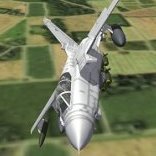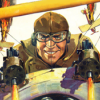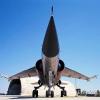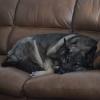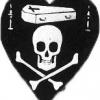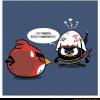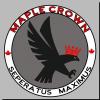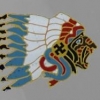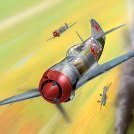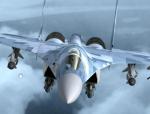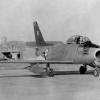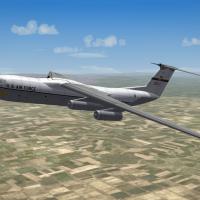Leaderboard
Popular Content
Showing most liked content on 02/23/2018 in all areas
-
10 points
-
7 pointsVVS Mig-21Bis FAPA jet during Operation Modular SA-3 in Iraq WIP stuff - "Grail" "Gaskin"
-
5 pointsAnd...one with a BIGGER bite. An E-2C Hawkeye of VAW-121 BlueTails.
-
5 points
-
4 points
-
4 pointsThe F-16XL was a design named after………..a golf ball………..that being the Top Flite XL for any who ever played Golf. Harry Hillaker was also a golfer….one with a problem in that the USAF wanted to use his A-A fighter (F-16A) in an A-G role, hanging lots of pods and bombs off it, which was just not on! So, what did he do and why? He and his design team at General Dynamics redesigned the F-16 to be more suitable to an A-G role using such concepts as high internal fuel loads and conformal carriage of weapons to get that nasty drag and radar cross section right down. In fact when he first started going to the Air Force with plans for the XL they were so enthusiastic about it they apparently accused him of holding the design back so that they (General Dynamics) could sell the F-16 twice. Goals to improve operational effectiveness included: • Improve the A-G role without degrading A-A capability. • Increased survivability, though increased speed, manoeuvrability and low radar cross section. The idea was to replace the F-16 and remain a lower cost fighter to the high cost F-15. So, some concept demonstrators were knocked together for testing? Yes, two of the Full Scale Development (Block Zero) F-16s were converted by doing such things as stretching their fuselages, removing the ventral strakes and gluing on some new cranked delta wings or double deltas. F-16XL-1 was 75-749 and had the F100-PW-200 engine, and F-16XL-2 was 75-747 which started life as single seater but was converted to the XL as a duel seater with the higher thrust F110-GE-100 engine. Were the goals met? Most of them, the low drag weapons carriage and lots of internal fuel meant vastly improved range over the F-16A (that already had comparative long legs), carried more A-G weapons, with ability to lug along 6 x A-A missiles on top. High AoA handling and instantaneous turn was improved. Cruise speed was also improved. This is a part of a 1989 write up by General Dynamics test pilot Joe Bill Dryden: Pitch rate in all configurations was as good as to slightly better than a Block 10 A model (No slouch in itself) and the roll response was better. On several occasions, during demonstrations with VIPs, I had to remind them that we had 12 MK82s on the airplane! They would frequently forget because of the ease with which the airplane would attain high airspeed…….How high an airspeed? Mull this over for a while, you put 6 MK82s on your little airplane, plus tanks and try to get close to my radius. ill put 12 x MK82s on board with no tanks, still go further than you can and for the same fuel flow by going 60 to 80 knots faster than you. I risk going in to the classified arena, but with the right fuses on the bombs you could get well on the plus side of the Mach, all the while enjoying a much better ride. Is there a but here? Yes using the F100-PW-200 engine from the F-16A, it was a tad underpowered, more F-14A than F-16A………..so take off requirements were nowhere near and some of it’s A-A capability was a bit degraded you could say. Perhaps an example from one of the Red Eagles pilots who flew some BFM against it in a MiG-21F-13: [Red Eagle Matheny flying the MiG] “We briefed each other about our airplanes and they [Edwards F-16XL pilots] turned to me and said they would be all over me – they had a roll rate of 800 degrees per second, which was the fastest in the inventory. – I got to thinking about that and it turned out the roll rate meant nothing. The problem with that airplane[F-16XL] was that it was a big bleeder: it just bled speed like nothing else when forced to turn hard – I ate them alive in the MiG-21. The F-15E on the other hand was a pretty good performer – they resisted the urge to get slow and jump in a phone booth with a MiG. They flew around the ranges at low level trying to burn off all this gas and he still needed to burn off more when we joined up on each other”. Could they not have improved that somewhere? Potentially, the second F-16XL had higher thrust F110-GE-100 engine but unfortunately the majority of the evaluation data and the Dual Role Fighter evaluation was done with the lesser thrusted F-100-PW-200. In fact Harry Hillaker stated they were not allowed to use the GE engine in the evaluation (see below) for whatever reason. NASA later got it supercruising with a F-100-GE-129 (29,500 lbs class), and by the late 1990s both General Electric and Pratt & Whitney offered suitable engines with a potential max thrust class to 36,000lbs and 37,000 lbs respectively. Was there some competition against the F-15 at some point? There was a USAF competitive evaluation originally called the Enhanced Tactical Fighter (ETF) competition, which in 1981 was renamed to became the Dual Role Fighter (DRF) competition. Technically not really a competition because both were evaluated and flight tested to totally different sets of conditions and to different flight test plans it seems. Why did the USAF run this evaluation? It was felt by some in the USAF the F-111F was becoming a bit outdated and instead of just an upgrade they wanted something that had A-A capability and a good precision night strike role against the Soviet masses. So, they chose two short assed fighters to replace the F-111? Pretty much – they would both get LANTIRN eventually and have a good A-A capability but still lacking in range. Surely the F-16 was cheaper was it not? On unit cost and cost per flight hour yes – but the USAF considered the F-16XL a radical new airframe compared to the F-15E, which was considered just a modification, so the USAF estimated research and development cost would be higher for the F-16XL. Okay but in the end the F-15 was chosen as the winner and that was that. No – following the DRF decision that the F-15E was going into production in February 1984, the USAF announced its intention to put the Single seat F-16XL into production anyway with the designation F-16F. So, work began on the F-16F design concept and Full Scale development into 1985. So where is it then? The program was terminated in late 1985 by the USAF it later appears there was no budget for every program out there such as the ATF (F-22) and black projects such as F-117 that were unknowns to most who ran the DRF so sadly the F-16F had to take the chop - basically lack of funding finally killed it off. End of the F-16XL – not quite The two F-16XLs were given to NASA in the late 1980s for various types of flight testing and we can thank them for taking some time to research into the history of the F-16XL and providing useful information on it. But there’s more An interesting rebuttal, ten years after the DRF, written by Harry Hillaker in response to an article in Aerotech News and Review which perhaps gives a passionate and better insight into how farcical some of these things can be: As the recognized “Father of the F-16,” and Chief Project Engineer during the concept formulation and preliminary design phases of the F-16XL and Vice President and Deputy Program Director during the prototype phase, the article was of considerable interest to me. The disappointment was that only one side of the issue was presented, a highly biased, self-interest input that does not adequately, nor accurately, present the real story of the selection of the F-15E. First, it should be understood that we (General Dynamics) did not initiate the F-16XL as a competitor to the F-15E, then identified as the F-15 Strike Eagle. We stated as unequivocally as possible to the Air Force, that the Dual-Role mission should be given to the F-15: that the F-15 should complement the F-16 in ground strike missions in the same manner that the F-16 complements the F-15 in air-air missions. A fundamental tenet of the F-16, from its inception, has been as an air-air complement to the F-15—no radar missile capability, no M=2.0+ capability, no standoff capability: a multi-mission fighter whose primary mission was air-surface with backup air-air capability. We proposed the F-16XL as a logical enhancement of its air-to-surface capabilities. The F-16C represented a progressive systems enhancement and the XL would be an airframe enhancement optimized more to its air-surface mission—lower weapons carriage drag and minimum dependence on external fuel tanks. The statement that “a prototype version of the F-15E decisively beat an F-16 variant called the F-16XL,” is misinformation. I don’t know what was meant by “beat,” it is patently true that McDonnell-Douglas clearly won what was called a “competition.” However, by the Air Force’s own definition, it was, in reality, an evaluation to determine which airplane would be better suited to the dual-role mission. In a formal competition, each party is evaluated against a common set of requirements and conditions. Such was not the case for the dual-role fighter. The F-15 Strike Eagle and the F-16XL were evaluated and flight tested to different sets of conditions and to different test plans—no common basis for evaluation existed. The F-15 had only one clear advantage in the evaluation—a “paper” advantage. The weapon loading for one of the missions used in the evaluation precluded the use of external fuel tanks on the F-16XL; the F-15 could carry that particular weapon loading and still carry external fuel tanks, the F-16XL could not. That one mission was the only place the F-15 had a clear advantage. (It should be noted that a fundamental design feature of the XL was the elimination of external fuel tanks with their attendant restrictions on flight limits and their weight and drag penalty.) Further, the Air Force would not allow us to use the GE F110 engine in our proposal even though the No. 2 XL, the 2-place version, was powered by a F110 engine and provided better performance than the P&W F100 engine. And although you would expect the F-16’s clear advantage to be cost, the Air Force treated the F-15E as a simple modification to a planned production buy and the F-16XL as a totally new buy. Neither airplane used in the flight test evaluation was a “prototype” of a dual-role fighter. The F-15 was closer systems and cockpit-wise than the F-16XL and the F-16XL was closer, much closer, airframe-wise. The F-16XLs were designed to, and flew, at their maximum design gross weight of 48,000 pounds, whereas the F-15, more than once, blew its tires while taxiing at 73,000 pounds, well below its maximum design gross weight [which was 81,000 pounds], a condition not demonstrated in the flight test program. In a meeting that I attended with General Creech, then TAC CINC [Commander-in-Chief], the general stated that either air¬plane was fully satisfactory. When asked why he and his staff only mentioned the F-15 (never the F-16XL) in any dual-role fighter statement or discussion, he gave a reply that was impossible to refute, “We have to do that because the F-16 has a heart and soul of its own and we have to sell the F-15.” I’ll have to admit that I sat mute upon hearing that statement because there was no possible retort. We had no allusions as to what the outcome of the Dual-role fighter “competition” would be and debated whether to even respond to the request for information. We did submit, knowing full well that it was a lost cause and that to not submit would be an affront to the Air Force who badly needed the appearance of a competition to justify continued procurement of the F-15—they had patently been unable to sell the F-15 Strike Eagle for five years. As is the case with too much in our culture today, the Air Force was more interested in style, in appearances, than in substance. Even today, I feel that giving the F-15 a precision air-surface capability was proper and badly needed. What continues to disturb me is that the F-16XL had to be a pawn in that decision and had to be so badly denigrated to justify the decision—a selection that could have been made on its own merits. And finally The concept of retaining performance with a usable Air to Ground loadout lives on today in the form of the F-35 Lightning II.......which comes with a 43,000 lbs thrust class engine to start with. General Dynamics F-16XL (F2275) ------------------------------------------------------------------------------------------------ Sources Page 267 Red Eagles (Davies.S), Osprey publishing 2008 - Matheny flew the MiG-21F-13 against the F-16XL and F-15E concept demonstrators. Elegance in Flight (Piccirillo.AC), 2014 National Aeronautics and Space Administration (NASA) – Chapter 7: The Dual Role Fighter competition. Code One Magazine, July 1989 (General Dynamics) Vol 4 No 2 -The F-16XL flies again Code One Magazine, July 1991 (General Dynamics) Vol 6 No 2 – Interview with Harry Hillaker 1999 Aviationweek online: http://aviationweek.com/awin/pws-229a-edging-close-500-hours Pratt&Whitney's self-funded F100-PW-229A - a re-fanned F100 fighter engine that can produce as much as 37,150 lbst. - is edging close to 500 total hours of run time 1998 General Electric online: http://www.geaviation.com/press/military/military_19980907.html Designated the F110-GE-129 EFE (Enhanced Fighter Engine), the engine will be qualified at 34,000 pounds of thrust and offered initially at a thrust rating of 32,000 pounds, with demonstrated growth capability to 36,000 pounds.
-
4 pointsI'm amazed. While testing the CL4, I blundered into a situation where gterl's superb map and VonS' equally superb atmospherics combine to make this old game engine look like a painting!
-
3 points
-
2 pointsLove the edition of the pics Tio!! The Sa-3 one is just amazing! Mandatory pic, Sabres over Europe...
-
2 points
-
2 pointsJust finished calibration for 2nd method. 30-40k feet, 1,5 and over Ma, retarded nuke. Ofc you must choose way of bombing before take off and load retarded or non-retarded WE-177 .
-
2 points
-
2 pointsnice esp with the buddy pods. did you do a new skin for it? looks different than the CC-150 i remember mandatory yet similarly themed screenie
-
1 point
-
1 pointand Kuwaiti single-seaters (based on A-4K-model with ini-edits and additional/corrected stuff)
-
1 point
-
1 pointit a model hasn't been mapped, then the lod has no texture statements within (just the applied materials). Without having the max file you'll NOT be able to skin it in any way, as decal statement must also be added to the lod (has decals=true). Just saying ... experimentation will most likely to be true as to the 47's pylons, ever thought of just using decals on them, since the mapping is fucked up? You just need to coordinates and have them facing left or right. Using the fake pilot method "fixes" them in place for all time, all galaxies and all loadouts (been there, done that with Wolf's P-47 Thunderbolts and several other WW2 birds that have mapping issue or missing pylons)
-
1 point
-
1 point
-
1 pointHi, Several interesting links about the Su-47 "Firkin": https://aviation.stackexchange.com/questions/33982/why-was-the-sukhoi-su-47-berkut-never-adopted-for-service https://www.airforce-technology.com/projects/s37/ https://www.militaryfactory.com/aircraft/detail.asp?aircraft_id=783
-
1 point
-
1 pointAlso: Single mission. It was: "The Italian Front" by @gterl DFW C.V "Reconnaissance mission"
-
1 pointView File SF2 A-4B Skyhawk VA-95 Det Q Skin/Decals Pack SF2 A-4B Skyhawk VA-95 Det Q Skin/Decals Pack 2/15/2018 = For SF2 (Any & All, Full-5 Merged Prefered) = *Can be used in any install that has access to the A-4B* A new skin for the A-4B Skyhawk. Also included, are a modified Data and loadout inis, correcting/adding to the Mission tasking loadouts, Player operated manual canopy, and the landing light. The skin included is for: VA-95, Det.Q embarked aboard USS BENNINGTON (CVS-20) circa 1964/64, in the Western Pacific When in-game, on the skin selection dropdown panel, you'll see: VA-93 Det Q (CVS-20,1964) Skins remain in their "as issued via 3W" stock bmp format. Most markings are decals, excepting certain color tags or other markings on the rudder These had to be painted on due to number-of-decals-per-mesh restrictions. There are 10 Modex and serial numbers (BuNums). All BuAerNums ARE historiclly correct; but not all could be matched to their corresponding Modex. Historically speaking, these A-4 squadrons (and/or detachments) were assigned to the Essex class carriers that had been convered to "CVS" or anti-submarine warfare carriers. The Skyhawks embarked were not only tasked with light strike, but Combat Air Patrols to protect the ship and the ASW assets. The canopy uses the Standard Animation Keystroke (tm), Shift/0. When in-game, on the skin selection dropdown panel, you'll see: VA-93 Det Q (CVS-20,1964) As always, fairly easy to follow, detailed install instructions are included. So, please read them .... Happy Landings! Wrench Kevin Stein Submitter Wrench Submitted 02/22/2018 Category A-4
-
1 point
-
1 pointShenyang J-31 Falcon Hawk - Korean People's Army Air Force, 2019 I made a simple skin for this and used a toned down version of the roundel and fin flash. At the moment, I've no modern 'red' weapons in my SF1 install so it all looks a bit bare.
-
1 point
-
1 pointdon't say such things on an open forum -- you could get banned from there!!! *** **sorry, the sarcasm don't come through in text!
-
1 point
-
1 point
-
1 point
-
1 pointNice work. I "borrowed" Stephen1918's excellent Hanriot files to temporarily get a test version of the Pfalz' younger brother working ingame.
-
1 point
-
1 pointAnd example. I turned off HUD and used only radar. It was non-retarded 10kT WE-177A. Initial speed/alt were over 1Ma/1000 ft. LOFT angle over 35 deg and distance of drop around 5.5-6 NM. I should turn back earlier, but was watching bomb ;-) Accuracy for this method is far, far enought . And I feel bad .... it was friendly air base ...
-
1 pointHave found interesting things here. Tonka can use WE-177 in 3 ways . 1) Laydown -> we can forget it ;-), no way to simulate 45s delay (or maybe I'm wrong??) 2) Low level LOFT -> I did non-retarded versions of WE for this method -> it's working well with present radar LOFT bombing. 3) Hi level RETARDED -> I must add calibration for this method to radar, but it's no problem now. deliverymethods.pdf
-
1 point
-
1 point
-
1 point
-
1 point
-
1 pointLOFT radar bombing ... prepare .. drop ... fly my bomb, fly ... ... and miss, but not much ;-)
-
1 point
-
1 point
-
1 point
-
1 point
-
1 pointyo Allen, i heard you like refuelers dawg....... so i got you a refueler refueling a refueler! (btw it is damn hard to keep formation in a jumbo!)
-
0 points
-
0 points
Important Information
By using this site, you agree to our Terms of Use, Privacy Policy, and We have placed cookies on your device to help make this website better. You can adjust your cookie settings, otherwise we'll assume you're okay to continue..


